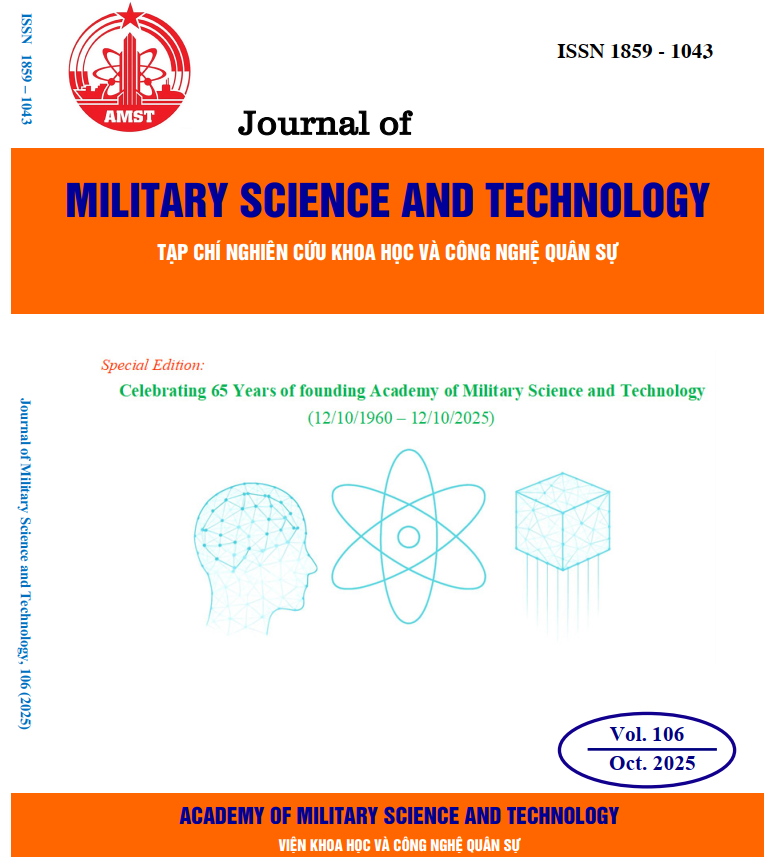Phương pháp thiết kế họa tiết ngụy trang điểm ảnh phù hợp với phông nền địa hình rừng núi
199 lượt xemDOI:
https://doi.org/10.54939/1859-1043.j.mst.106.2025.121-128Từ khóa:
Họa tiết ngụy trang dạng điểm ảnh; Chỉ số đánh giá; PSNR; Giao nhau biểu đồ màu.Tóm tắt
Ngụy trang là yếu tố quan trọng trong các hoạt động quân sự hiện đại, giúp đối tượng hòa trộn trực quan với môi trường xung quanh. Các mẫu ngụy trang gây rối truyền thống, từng được sử dụng rộng rãi từ những năm 1970 đến đầu những năm 2000, đang dần được thay thế bởi họa tiết dạng điểm ảnh. Nghiên cứu này đề xuất một phương pháp thiết kế họa tiết ngụy trang điểm ảnh phù hợp với địa hình rừng. Hiệu quả được đánh giá thông qua hai chỉ số: Tỷ số tín hiệu trên nhiễu đỉnh (PSNR) và Đánh giá tương đồng phân bố màu bằng Histogram Intersection (HI), phản ánh mức độ tương đồng về thị giác và phân bố màu sắc. Kết quả cho thấy các họa tiết được thiết kế có màu sắc và kết cấu gần giống với nền rừng, cho thấy tiềm năng ứng dụng thực tiễn.
Tài liệu tham khảo
[1]. Q. Jia et al, “Design and evaluation of digital camouflage pattern by spot combination,” Multim. Tools Appl., vol. 79, no. 29, pp. 22047-22064, (2020). DOI: https://doi.org/10.1007/s11042-020-09002-5
[2]. S. Choudhary, R. Sharma, “Terrain Specific Real-Time Pixelated Camouflage Texture Generation and its Impact Assessment,” Def. Sci. J., vol. 72, no. 6, pp. 824-835, (2022). DOI: https://doi.org/10.14429/dsj.72.17599
[3]. X. Wei et al, “A novel method for automatic camouflage pattern synthesize,” IEEE Access, vol. 9, pp. 67559-67568, (2021). DOI: https://doi.org/10.1109/ACCESS.2021.3077258
[4]. Santos, “Camouflage US Marine Corps combat utility uniform: pattern, fabric, and design,” United States Patent 10/967,885, (2009).
[5]. M. Friskovec and H. Gabrijelcic, “Development of a procedure for camouflage pattern design,” Fibres & Textiles in Eastern Europe, vol. 18, no. 4, p. 81 (2010).
[6]. M. D. Witting, D. Goyal, “Normal pupillary size in fluorescent and bright light”, Ann Emerg Med, vol. 41, no. 2, pp. 247-250, (2003). DOI: https://doi.org/10.1067/mem.2003.8
[7]. Nguyen Ngoc Son et al, “Method for designing camouflage patterns blend to the natural backgrounds,” Journal of Military Science and Technology, vol. 92, pp. 121-129, (2023).
[8]. M. Ahmed, R. Seraj, SMS Islam, “The k-means Algorithm: A Comprehensive Survey and Performance Evaluation,” Electronics, vol. 9, no. 8, p. 1295, (2020). DOI: https://doi.org/10.3390/electronics9081295
[9]. F. Xue et al, “Design of digital camouflage by recursive overlapping of pattern templates,” Neurocomputing, vol. 172, pp. 262-270, (2016). DOI: https://doi.org/10.1016/j.neucom.2014.12.108
[10]. M. Friskovec, H.Gabrijelcic and B. Simoncic, “Design and evaluation of a camouflage pattern for Slovenian urban environment, ” JIST, vol. 54, no. 2, pp. 20507-1, (2010). DOI: https://doi.org/10.2352/J.ImagingSci.Technol.2010.54.2.020507
[11]. N. T. Lam et al, “Developing a method to generate an adaptive real-time camouflage pattern based on electro-chromic active devices,” Journal of Military Science and Technology, vol. 99, pp. 78-88, (2024). DOI: https://doi.org/10.54939/1859-1043.j.mst.99.2024.78-88
[12]. C. J. Lin et al, “Developing a similarity index for static camouflaged target detection,” Imaging Sci. J., vol. 62, no. 6, p. 341, (2014). DOI: https://doi.org/10.1179/1743131X13Y.0000000057
[13]. Z. Wang, A. C. Bovik, “A universal image quality index,” IEEE Signal Process. Lett., vol. 9, no. 3, pp. 81-84, (2002). DOI: https://doi.org/10.1109/97.995823
[14]. Tran Tien Bao et al, “A method to evaluate camouflage effectiveness by computer simulation,” Journal of Military Science and Technology, vol. 90, pp. 119-126, (2023).
[15]. Do Xuan Doanh et al, “Multicriteria evaluation method applied in the field of camouflage,” Journal of Military Science and Technology, Special Issue on FEE, pp. 154-163, (2022). DOI: https://doi.org/10.54939/1859-1043.j.mst.FEE.2022.154-163
[16]. C. J. Lin et al, “Developing and evaluating a target-background similarity metric for camouflage detection,” PLoS One, vol. 9, no. 2, p. e87310 (2014). DOI: https://doi.org/10.1371/journal.pone.0087310
[17]. S. M. Lee et al, “Evaluation of image similarity by histogram intersection,” Color Res. Appl., vol. 30, no. 4, pp. 265-274, (2005). DOI: https://doi.org/10.1002/col.20122
[18]. Y. Zheng, M. Agnani, and M. Singh, “Identification of grey sheep users by histogram intersection in recommender systems,” in Advanced Data Mining and Applications: 13th International Conference, ADMA 2017, Singapore, November 5–6, 2017, Proceedings 13, Springer International Publishing, pp. 148–161 (2017). DOI: https://doi.org/10.1007/978-3-319-69179-4_11







